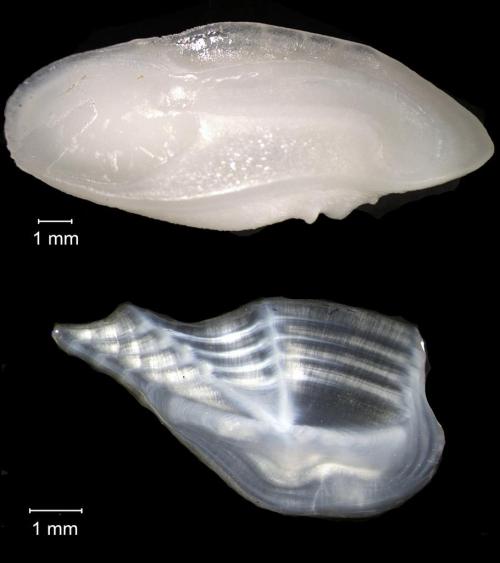Come And Take A “bite” Out Of Nature & Science, Attending Explorers Society Members Event. #northmuseum

Come and take a “bite” out of nature & science, attending Explorers Society Members Event. #northmuseum #stemsisters #sharks (at North Museum of Nature & Science)
More Posts from Llamaslikesciencetoo and Others

Vaterite … from fish ears to crystal lattices
Deep within the ear of a fish you will find a little bone, an otolith. This bone acts as part of the sensory system of the ear, part accelerometer, part gravity sensor, part sound sensor. Otoliths are formed from calcium carbonate minerals, and different species of fish exploit different types of CaCO3 mineral. These CaCO3 “polymorphs” all have the same chemistry, but the arrangements of atoms within the crystal lattice of each are different, just as diamond and graphite are two polymorphs of carbon. Usually, a fish otolith grows as aragonite, sometimes as calcite, a different polymorph of calcium carbonate, and sometime as the third CaCO3 polymorph, vaterite.
Keep reading

Updated visalization of every Vaquita left on Earth
There are supposed to be 5000 of them. Now there are 30.
What has been done so far has not worked, including the ban on gill nets, and the capture effort that is coming will probably be far too late.
This is humanity’s fault.
China for pushing the market for totoaba swim bladders, Mexico for allowing it until this point, and the rest of us for not stepping up until they are at death’s door.
This species will most likely be gone in one or two years, and it will be the second cetacean species to die out in a little over ten years, the second in the entire 200 000 year history of the human species.


Plate 12. Jellies. Histoire naturelle des zoophytes. Acalèphes. 1843.








Uncovering the Willow Ptarmigan Diorama
OKAY SO THIS IS COOL. The Reptile Hall is getting ready to undergo some renovations, and the first step in the process was to dismantle the square diorama case which previously housed Carl Akeley’s striped hyenas in the corner of the hall. But what NOBODY EXPECTED was to find a hidden diorama that had been blocked from view for ??? years.
Not only that, this is a really, really cool diorama because it’s actually two dioramas in one. The lighting mechanism isn’t functional right now, but when you approach you notice that it’s dark. The idea is that there’d be two lighting sources, two scenes (with two animals) that mirror one another, and a two way mirror.
The photos I snapped depict a willow ptarmigan (Lagopus lagopus) in a summer scene, sporting its summer plumage. In the winter, the bird’s plumage turns white. Here, the summer diorama is actually mounted to the ceiling of the diorama case, so when you shine a light through the front of the glass, that’s what is reflected back from the two way mirror. That means, behind the mirror is the second diorama: the winter scene, with a reversed taxidermied ptarmigan in a mirrored, winter landscape. Visitors could then approach the diorama and experience two different camouflage phases of the same animal, seamlessly fading from one to the other.
I hope we can fix up the lights again soon because this is AWESOME
Ptarmigan Bird Exhibit, Seasonal Plumage, Hall 20 diorama © The Field Museum, Z86694 and © The Field Museum, Z86693.




Women in Science: 50 Fearless Pioneers Who Changed the World by Rachel Ignotofsky
I have been following @rachelignotofsky on Tumblr for several years, and I’m truly happy to see her creative art of brilliant scientists now being in a book. These amusing illustrations together with educational information make a fantastic combination. I’m getting the book for my little sister but it’s definitely a great read for everyone. You can order the book HERE.



Just some lesser known facts about octopuses you guys might like.

x

A starfish walking back to the water.
-
 boop96 liked this · 8 years ago
boop96 liked this · 8 years ago -
 purple---princesss liked this · 8 years ago
purple---princesss liked this · 8 years ago -
 cetacean-central reblogged this · 8 years ago
cetacean-central reblogged this · 8 years ago -
 sergeanthunderfists liked this · 8 years ago
sergeanthunderfists liked this · 8 years ago -
 tlyersmolbeanbaby-blog reblogged this · 8 years ago
tlyersmolbeanbaby-blog reblogged this · 8 years ago -
 tlyersmolbeanbaby-blog liked this · 8 years ago
tlyersmolbeanbaby-blog liked this · 8 years ago -
 9215emanresu liked this · 8 years ago
9215emanresu liked this · 8 years ago -
 ifindmyselfaloneagain liked this · 8 years ago
ifindmyselfaloneagain liked this · 8 years ago -
 themartiansdaughter reblogged this · 8 years ago
themartiansdaughter reblogged this · 8 years ago -
 godgoogle reblogged this · 8 years ago
godgoogle reblogged this · 8 years ago -
 nompeople reblogged this · 8 years ago
nompeople reblogged this · 8 years ago -
 llamaslikesciencetoo reblogged this · 8 years ago
llamaslikesciencetoo reblogged this · 8 years ago -
 llamafollower liked this · 8 years ago
llamafollower liked this · 8 years ago -
 introvertsavenue liked this · 8 years ago
introvertsavenue liked this · 8 years ago -
 tragicmagicxo-blog reblogged this · 8 years ago
tragicmagicxo-blog reblogged this · 8 years ago -
 mathyus33 liked this · 8 years ago
mathyus33 liked this · 8 years ago -
 dragontidess liked this · 8 years ago
dragontidess liked this · 8 years ago -
 toothybabies reblogged this · 8 years ago
toothybabies reblogged this · 8 years ago -
 charlesdicomo reblogged this · 8 years ago
charlesdicomo reblogged this · 8 years ago
Mainly interested in ecology, but also the entirety of science.
179 posts